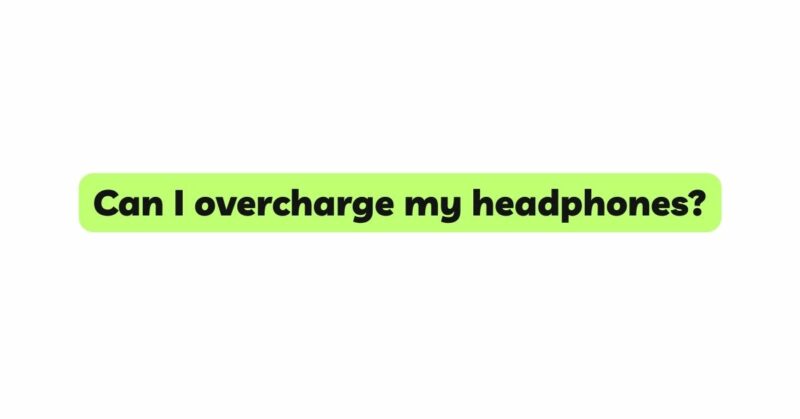In today’s tech-savvy world, wireless headphones have become an essential accessory for music enthusiasts and on-the-go individuals. With the increasing reliance on these devices, concerns about battery health and charging practices have also surfaced. One of the most common questions asked is whether it is possible to overcharge wireless headphones. In this article, we will debunk the myth surrounding headphone overcharging, provide insights into the charging process for wireless headphones, and explore the safety mechanisms in place to protect their batteries. By understanding these factors, we aim to shed light on the truth behind headphone charging and help users make informed decisions to optimize battery performance and prolong their headphone’s lifespan.
- Understanding the Charging Process for Wireless Headphones:
To comprehend whether headphones can be overcharged, it’s essential to understand the charging process. Wireless headphones, like other electronic devices, rely on rechargeable batteries, often lithium-ion (Li-ion) batteries, for power. When connected to a power source, electricity flows into the headphone’s battery, where it is converted into chemical energy and stored for future use.
- The Truth About Lithium-ion Batteries:
Lithium-ion batteries are the preferred choice for most modern electronic devices due to their numerous advantages, including high energy density, lightweight design, and reduced self-discharge rates. Compared to older nickel-based batteries, Li-ion batteries offer improved performance, longer life cycles, and enhanced safety features.
- How Lithium-ion Batteries Work:
Lithium-ion batteries operate through the movement of lithium ions between the positive and negative electrodes during charging and discharging. When fully charged, the movement of lithium ions is halted, preventing further charging and safeguarding the battery against overcharging.
- Debunking the Overcharging Myth:
The myth of overcharging headphones is based on outdated battery technologies that were susceptible to overcharging, leading to reduced battery life and potential hazards. However, modern lithium-ion batteries have advanced safety features that effectively prevent overcharging.
- Safety Mechanisms Against Overcharging:
To protect against overcharging, manufacturers incorporate several safety mechanisms in wireless headphones:
a) Voltage Regulators: Headphones are equipped with voltage regulators that control the voltage level during charging, preventing excessive voltage from reaching the battery.
b) Smart Charging Circuits: Most modern headphones are equipped with intelligent charging circuits that automatically cease charging once the battery reaches full capacity. This feature prevents overcharging and shields the battery from potential damage.
c) Deep Sleep Mode: Some headphone models activate a low-power deep sleep mode once the battery is fully charged. This minimizes energy consumption and reduces the risk of battery damage due to prolonged charging.
- Can You Really Overcharge Your Headphones?
The truth is that with these advanced safety mechanisms in place, it is virtually impossible to overcharge modern wireless headphones. Once the battery reaches its full capacity, the charging process is automatically halted, preventing any further flow of electricity into the battery cells.
- Practical Tips for Maximizing Battery Life:
While overcharging is not a significant concern, there are practical tips you can follow to optimize battery life and performance:
a) Partial Charging: Charging your headphones partially, such as when the battery is low or around 50%, can help extend battery life.
b) Charge Before Use: Charge your headphones before using them, rather than leaving them plugged in after they are fully charged, to prevent unnecessary exposure to high voltage.
c) Unplug When Fully Charged: If you choose to charge your headphones overnight, unplug them once they reach full capacity to prevent overcharging.
d) Charge in Moderation: Avoid excessive charging or charging too frequently, as this can contribute to battery degradation over time.
e) Proper Storage: If you plan to store your headphones for an extended period, ensure they are charged to around 50% before storing them in a cool, dry place, away from direct sunlight.
f) Follow Manufacturer’s Guidelines: Refer to the user manual or product documentation for specific charging recommendations provided by the headphone manufacturer.
- Factors Affecting Battery Life:
Various factors can influence the overall battery life of wireless headphones:
a) Volume Levels: Playing audio at higher volume levels can consume more power, leading to faster battery drain.
b) Usage Patterns: Continuous music playback, frequent phone calls, and extended use of features like noise-cancellation can also impact battery life.
c) Ambient Conditions: Extreme temperatures, both hot and cold, can influence battery performance.
- Battery Health and Replacement:
Over time, battery performance may naturally degrade. If you notice a significant decrease in battery life or if the battery no longer holds a charge as it used to, consider getting the battery replaced through an authorized service center.
Conclusion:
The fear of overcharging wireless headphones is a myth, primarily perpetuated by older battery technologies that were susceptible to damage from continuous charging. Modern wireless headphones, equipped with lithium-ion batteries and advanced safety mechanisms, prevent overcharging and protect battery health. As a result, you can confidently charge your wireless headphones overnight or for extended periods without worrying about damage to the battery. To optimize battery life and performance, follow the practical tips provided, and be mindful of usage patterns and ambient conditions. Armed with this knowledge, you can enjoy a seamless audio experience with your wireless headphones, assured of their long-lasting performance and extended battery life.


